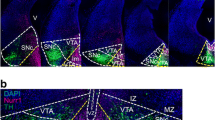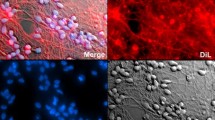Abstract
Alcohol and aldehyde dehydrogenases (ADHs and ALDHs) may be of interest in the pathology of Parkinson's disease (PD) because of their role in protection against toxins and in retinoid metabolism, which is required for growth and development of the mesencephalic dopamine system. In the present study, the spatial and temporal expression patterns of Adh1, Adh3, Adh4, and Aldh1 mRNAs in embryonic C57BL/6 mice (E9.5-E19.5) and Sprague-Dawley rats (E12.5-P0) have been investigated by using radioactive oligonucleotide in situ hybridization. High expression of Aldh1 mRNA was found in the developing mesencephalic dopamine neurons of both mice and rats. Expression of Adh1 and Adh4 mRNAs was observed in adrenal cortex and olfactory epithelium in mice. Additionally, Adh1 was expressed in epidermis, liver, conjunctival, and intestinal epithelium. In rat embryos, expression was less extensive, with Adh1 mRNA being found in liver and intestines. Adh3 expression was ubiquitous in both mouse and rat embryos, suggesting a housekeeping function of the gene. Consistent with previous studies in adult rats and mice, our data suggest that Adh3 is the only ADH class present in rodent brain. Adh and Aldh gene activity in mouse and rat embryos indicate the possible involvement of the respective enzymes in retinoid metabolism and participation in defense against toxic insults, including those that may be involved in the pathogenesis of PD.





Similar content being viewed by others
References
Allali-Hassani A, Peralba JM, Martras S, Farres J, Pares X (1998) Retinoids, omega-hydroxyfatty acids and cytotoxic aldehydes as physiological substrates, and H2-receptor antagonists as pharmacological inhibitors, of human class IV alcohol dehydrogenase. FEBS Lett 426:362–366
Anchan RM, Drake DP, Haines CF, Gerwe EA, LaMantia AS (1997) Disruption of local retinoid-mediated gene expression accompanies abnormal development in the mammalian olfactory pathway. J Comp Neurol 379:171–184
Ang HL, Duester G (1997) Initiation of retinoid signaling in primitive streak mouse embryos: spatiotemporal expression patterns of receptors and metabolic enzymes for ligand synthesis. Dev Dyn 208:536–543
Ang HL, Deltour L, Hayamizu TF, Zgombic-Knight M, Duester G (1996a) Retinoic acid synthesis in mouse embryos during gastrulation and craniofacial development linked to class IV alcohol dehydrogenase gene expression. J Biol Chem 271:9526–9534
Ang HL, Deltour L, Zgombic-Knight M, Wagner MA, Duester G (1996b) Expression patterns of class I and class IV alcohol dehydrogenase genes in developing epithelia suggest a role for alcohol dehydrogenase in local retinoic acid synthesis. Alcohol Clin Exp Res 20:1050–1064
Boleda MD, Saubi N, Farres J, Pares X (1993) Physiological substrates for rat alcohol dehydrogenase classes: aldehydes of lipid peroxidation, omega-hydroxyfatty acids, and retinoids. Arch Biochem Biophys 307:85–90
Buervenich S, Sydow O, Carmine A, Zhang Z, Anvret M, Olson L (2000) Alcohol dehydrogenase alleles in Parkinson's disease. Mov Disord 15:813–818
Buervenich S, Carmine A, Galter D, Shahabi HN, Johnels B, Holmberg B, Ahlberg J, Nissbrandt H, Eerola J, Hellström O, Tienari PJ, Matsuura T, Ashizawa T, Wüllner U, Klockgether T, Zimprich A, Gasser T, Hanson M, Waseem S, Singleton A, McMahon FJ, Anvret M, Sydow O, Olson L (2005) A rare truncating mutation in ADH1C (G78Stop) shows significant association with Parkinson disease in a large international sample. Arch Neurol 62:74–78
Cederlund E, Peralba JM, Pares X, Jörnvall H (1991) Amphibian alcohol dehydrogenase, the major frog liver enzyme. Relationships to other forms and assessment of an early gene duplication separating vertebrate class I and class III alcohol dehydrogenases. Biochemistry 30:2811–2816
Cheung C, Davies NG, Höög JO, Hotchkiss SA, Smith Pease CK (2003) Species variations in cutaneous alcohol dehydrogenases and aldehyde dehydrogenases may impact on toxicological assessments of alcohols and aldehydes. Toxicology 184:97–112
Connor MJ, Smit MH (1987) Terminal-group oxidation of retinol by mouse epidermis. Inhibition in vitro and in vivo. Biochem J 244:489–492
Dagerlind A, Friberg K, Bean AJ, Hökfelt T (1992) Sensitive mRNA detection using unfixed tissue: combined radioactive and non-radioactive in situ hybridization histochemistry. Histochemistry 98:39–49
Deltour L, Haselbeck RJ, Ang HL, Duester G (1997) Localization of class I and class IV alcohol dehydrogenases in mouse testis and epididymis: potential retinol dehydrogenases for endogenous retinoic acid synthesis. Biol Reprod 56:102–109
Deltour L, Foglio MH, Duester G (1999) Metabolic deficiencies in alcohol dehydrogenase Adh1, Adh3, and Adh4 null mutant mice. Overlapping roles of Adh1 and Adh4 in ethanol clearance and metabolism of retinol to retinoic acid. J Biol Chem 274:16796–16801
Duester G (1996) Involvement of alcohol dehydrogenase, short-chain dehydrogenase/reductase, aldehyde dehydrogenase, and cytochrome P450 in the control of retinoid signaling by activation of retinoic acid synthesis. Biochemistry 35:12221–12227
Duester G, Deltour L, Ang HL (1997) Evidence that class IV alcohol dehydrogenase may function in embryonic retinoic acid synthesis. Adv Exp Med Biol 414:357–364
Duester G, Farres J, Felder MR, Holmes RS, Höög JO, Pares X, Plapp BV, Yin SJ, Jörnvall H (1999) Recommended nomenclature for the vertebrate alcohol dehydrogenase gene family. Biochem Pharmacol 58:389–395
Galter D, Buervenich S, Carmine A, Anvret M, Olson L (2003a) ALDH1 mRNA: presence in human dopamine neurons and decreases in substantia nigra in Parkinson's disease and in the ventral tegmental area in schizophrenia. Neurobiol Dis 14:637–647
Galter D, Carmine A, Buervenich S, Duester G, Olson L (2003b) Distribution of class I, III and IV alcohol dehydrogenase mRNAs in the adult rat, mouse and human brain. Eur J Biochem 270:1316–1326
Haselbeck RJ, Duester G (1997) Regional restriction of alcohol/retinol dehydrogenases along the mouse gastrointestinal epithelium. Alcohol Clin Exp Res 21:1484–1490
Haselbeck RJ, Duester G (1998a) ADH4-lacZ transgenic mouse reveals alcohol dehydrogenase localization in embryonic midbrain/hindbrain, otic vesicles, and mesencephalic, trigeminal, facial, and olfactory neural crest. Alcohol Clin Exp Res 22:1607–1613
Haselbeck RJ, Duester G (1998b) ADH1 and ADH4 alcohol/retinol dehydrogenases in the developing adrenal blastema provide evidence for embryonic retinoid endocrine function. Dev Dyn 213:114–120
Haselbeck RJ, Ang HL, Deltour L, Duester G (1997a) Retinoic acid and alcohol/retinol dehydrogenase in the mouse adrenal gland: a potential endocrine source of retinoic acid during development. Endocrinology 138:3035–3041
Haselbeck RJ, Ang HL, Duester G (1997b) Class IV alcohol/retinol dehydrogenase localization in epidermal basal layer: potential site of retinoic acid synthesis during skin development. Dev Dyn 208:447–453
Holmquist B, Vallee BL (1991) Human liver class III alcohol and glutathione dependent formaldehyde dehydrogenase are the same enzyme. Biochem Biophys Res Commun 178:1371–1377
Höög J, Brandt M, Hedberg JJ, Strömberg P (2001) Mammalian alcohol dehydrogenase of higher classes: analyses of human ADH5 and rat ADH6. Chem Biol Interact 130–132:395–404
Jörnvall H, Danielsson O, Hjelmqvist L, Persson B, Shafqat J (1995) The alcohol dehydrogenase system. Adv Exp Med Biol 372:281–294
Kedishvili NY, Bosron WF, Stone CL, Hurley TD, Peggs CF, Thomasson HR, Popov KM, Carr LG, Edenberg HJ, Li TK (1995) Expression and kinetic characterization of recombinant human stomach alcohol dehydrogenase. Active-site amino acid sequence explains substrate specificity compared with liver isozymes. J Biol Chem 270:3625–3630
Klein-Szanto AJ, Martin DH, Pine AH (1980) Cutaneous manifestations in rats with advanced vitamin A deficiency. J Cutan Pathol 7:260–270
Koivusalo M, Baumann M, Uotila L (1989) Evidence for the identity of glutathione-dependent formaldehyde dehydrogenase and class III alcohol dehydrogenase. FEBS Lett 257:105–109
Kurlandsky SB, Gamble MV, Ramakrishnan R, Blaner WS (1995) Plasma delivery of retinoic acid to tissues in the rat. J Biol Chem 270:17850–17857
Lange LG, Sytkowski AJ, Vallee BL (1976) Human liver alcohol dehydrogenase: purification, composition, and catalytic features. Biochemistry 15:4687–4693
Li TK, Bosron WF, Dafeldecker WP, Lange LG, Vallee BL (1977) Isolation of pi-alcohol dehydrogenase of human liver: is it a determinant of alcoholism? Proc Natl Acad Sci U S A 74:4378–4381
Mårdh G, Dingley AL, Auld DS, Vallee BL (1986) Human class II (pi) alcohol dehydrogenase has a redox-specific function in norepinephrine metabolism. Proc Natl Acad Sci U S A 83:8908–8912
McCaffery P, Drager UC (1994) High levels of a retinoic acid-generating dehydrogenase in the meso-telencephalic dopamine system. Proc Natl Acad Sci U S A 91:7772–7776
Niwa T, Maruyama W, Nakahara D, Takeda N, Yoshizumi H, Tatematsu A, Takahashi A, Dostert P, Naoi M, Nagatsu T (1992) Endogenous synthesis of N-methylsalsolinol, an analogue of 1-methyl-4-phenyl-1,2,3,6-tetrahydropyridine, in rat brain during in vivo microdialysis with salsolinol, as demonstrated by gas chromatography-mass spectrometry. J Chromatogr 578:109–115
Ross SA, McCaffery PJ, Drager UC, De Luca LM (2000) Retinoids in embryonal development. Physiol Rev 80:1021–1054
Sun HW, Plapp BV (1992) Progressive sequence alignment and molecular evolution of the Zn-containing alcohol dehydrogenase family. J Mol Evol 34:522–535
Tietjen TG, Mjaatvedt CH, Yang VW (1994a) Cellular localization of the class I alcohol dehydrogenase transcript in adult rat tissues. Histochem J 26:526–532
Tietjen TG, Mjaatvedt CH, Yang VW (1994b) Expression of the class I alcohol dehydrogenase gene in developing rat fetuses. J Histochem Cytochem 42:745–753
Vaglenova J, Martinez SE, Porte S, Duester G, Farres J, Pares X (2003) Expression, localization and potential physiological significance of alcohol dehydrogenase in the gastrointestinal tract. Eur J Biochem 270:2652–2662
Vonesch JL, Nakshatri H, Philippe M, Chambon P, Dolle P (1994) Stage and tissue-specific expression of the alcohol dehydrogenase 1 (Adh-1) gene during mouse development. Dev Dyn 199:199–213
Yang ZN, Davis GJ, Hurley TD, Stone CL, Li TK, Bosron WF (1994) Catalytic efficiency of human alcohol dehydrogenases for retinol oxidation and retinal reduction. Alcohol Clin Exp Res 18:587–591
Yasunami M, Chen CS, Yoshida A (1991) A human alcohol dehydrogenase gene (ADH6) encoding an additional class of isozyme. Proc Natl Acad Sci U S A 88:7610–7614
Yoritaka A, Hattori N, Uchida K, Tanaka M, Stadtman ER, Mizuno Y (1996) Immunohistochemical detection of 4-hydroxynonenal protein adducts in Parkinson disease. Proc Natl Acad Sci U S A 93:2696–2701
Zetterström RH, Simon A, Giacobini MM, Eriksson U, Olson L (1994) Localization of cellular retinoid-binding proteins suggests specific roles for retinoids in the adult central nervous system. Neuroscience 62:899–918
Zetterström RH, Lindqvist E, Mata de UA, Tomac A, Eriksson U, Perlmann T, Olson L (1999) Role of retinoids in the CNS: differential expression of retinoid binding proteins and receptors and evidence for presence of retinoic acid. Eur J Neurosci 11:407–416
Zile MH (1998) Vitamin A and embryonic development: an overview. J Nutr 128:455S
Acknowledgements
We thank Eva Lindqvist, Karin Lundströmer, and Karin Pernold for technical assistance.
Author information
Authors and Affiliations
Corresponding author
Additional information
This work was supported by grants from the Swedish Research Council, the Swedish Parkinson Foundation, the Swedish Brain Foundation, Karolinska Institutet funds, AstraZeneca, and the US Public Health Service.
Rights and permissions
About this article
Cite this article
Westerlund, M., Galter, D., Carmine, A. et al. Tissue- and species-specific expression patterns of class I, III, and IV Adh and Aldh1 mRNAs in rodent embryos. Cell Tissue Res 322, 227–236 (2005). https://doi.org/10.1007/s00441-005-0038-7
Received:
Accepted:
Published:
Issue Date:
DOI: https://doi.org/10.1007/s00441-005-0038-7




